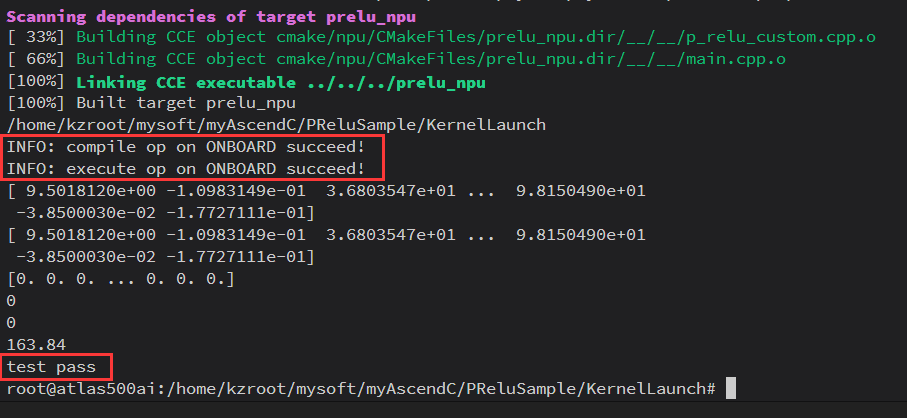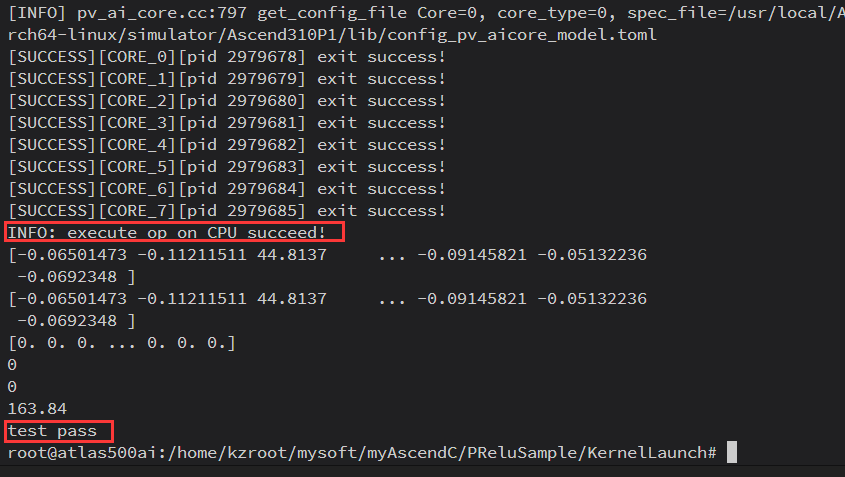
本文分享自华为云社区《Ascend C 自定义算子 Kernel Launch调用入门》,作者: jackwangcumt。
1 Kernel Launch概述
根据官方说明文档的介绍,Ascend C对外开放核函数的基础调用(Kernel Launch)方式,是为了简化Ascend C 自定义算子的开发流程,提供更易用的调试调优功能。当开发者完成算子核函数的开发和Tiling实现后,即可通过AscendCL运行时接口,完成算子的调用并实现自己的推理应用;同时提供简易的kernel开发工程,开发者仅需提供kernel侧实现,基于工程框架可以快速实现Kernel Launch。本文实验前提是完成了《Ascend C 自定义PRelu算子》博文的相关算子开发工程。网址为:https://bbs.huaweicloud.com/blogs/425244 。请注意:
- 8.0.RC1.alpha002当前版本,Kernel Launch开放式编程为试用特性,不支持应用于商用产品中。
- 8.0.RC1.alpha002当前版本暂不支持获取用户workspace特性。
2 Kernel Launch调用方式
ACLRT_LAUNCH_KERNEL调用方式对内核调用符方式进行了功能加强,核函数的调用是异步的,调用接口的使用方法如下:
ACLRT_LAUNCH_KERNEL(kernel_name)(blockDim, stream, argument list);
- kernel_name:算子核函数的名称。
- blockDim:规定了核函数将会在几个核上执行。每个执行该核函数的核会被分配一个逻辑ID,即block_idx,可以在核函数的实现中调用GetBlockIdx来获取block_idx。
- stream,类型为aclrtStream,stream用于维护一些异步操作的执行顺序,确保按照应用程序中的代码调用顺序在Device上执行。
- argument list:参数列表,与核函数的参数列表保持一致。
为帮助开发者快速的完成算子的Kernel Launch调试,官方提供了简易的算子工程,我们可以基于该算子工程中的样例代码和工程框架进行算子开发。算子工程支持的如下:
- 该工程支持调试功能,如PRINTF功能、DumpTensor。
- 工程编译生成的应用程序,可通过msprof命令行方式采集和解析性能数据。
可以参考工程样例:https://gitee.com/ascend/samples/blob/master/operator/AddCustomSample/KernelLaunch/AddKernelInvocationTilingNeo ,其目录结构如下所示:
AddKernelInvocationNeo |-- cmake // CMake编译文件 |-- scripts | ├── gen_data.py // 输入数据和真值数据生成脚本文件 | ├── verify_result.py // 验证输出数据和真值数据是否一致的验证脚本 |-- CMakeLists.txt // CMake编译配置文件 |-- add_custom.cpp // 矢量算子kernel实现 |-- data_utils.h // 数据读入写出函数 |-- main.cpp // 主函数,调用算子的应用程序,含CPU域及NPU域调用 |-- run.sh // 编译运行算子的脚本
基于该算子工程,开发者进行算子开发的步骤如下:
- 完成算子kernel侧实现。
- 编写算子调用应用程序main.cpp。
-
编写CMake编译配置文件CMakeLists.txt。
- 根据实际需要修改输入数据和真值数据生成脚本文件gen_data.py和验证输出数据和真值数据是否一致的验证脚本verify_result.py。
- 根据实际需要修改编译运行算子的脚本run.sh并执行该脚本,完成算子的编译运行和结果验证。
3 Kernel Launch实现
在PReluSample目录下新建一个目录KernelLaunch,用于存放Kernel Launch调用方式的工程代码,我这里参考官方的https://gitee.com/ascend/samples/tree/master/operator/LeakyReluCustomSample/KernelLaunch/
LeakyReluKernelInvocation样例工程,并修改了相关参数,p_relu_custom.cpp 代码如下所示:
#include "kernel_operator.h"
using namespace AscendC;
constexpr int32_t BUFFER_NUM = 2;
constexpr int32_t TOTAL_LENGTH = 8 * 200 * 1024;
constexpr int32_t TILE_NUM = 32;
constexpr float alpha = 0.002;
class KernelPRelu {
public:
__aicore__ inline KernelPRelu() {}
__aicore__ inline void Init(GM_ADDR x, GM_ADDR y, uint32_t totalLength, uint32_t tileNum, float alpha)
{
PRINTF("[npu debug] >>> GetBlockNum() %d", GetBlockNum());
ASSERT(GetBlockNum() != 0 && "block dim can not be zero!");
this->blockLength = totalLength / GetBlockNum();
this->tileNum = tileNum;
this->alpha = static_cast(alpha);
ASSERT(tileNum != 0 && "tile num can not be zero!");
this->tileLength = this->blockLength / tileNum / BUFFER_NUM;
// get start index for current core, core parallel
xGm.SetGlobalBuffer((__gm__ float*)x + this->blockLength * GetBlockIdx(), this->blockLength);
yGm.SetGlobalBuffer((__gm__ float*)y + this->blockLength * GetBlockIdx(), this->blockLength);
// pipe alloc memory to queue, the unit is Bytes
pipe.InitBuffer(inQueueX, BUFFER_NUM, this->tileLength * sizeof(float));
pipe.InitBuffer(outQueueY, BUFFER_NUM, this->tileLength * sizeof(float));
pipe.InitBuffer(tmpBuffer1, this->tileLength * sizeof(float));
//pipe.InitBuffer(tmpBuffer2, this->tileLength * sizeof(float));
}
__aicore__ inline void Process()
{
// loop count need to be doubled, due to double buffer
int32_t loopCount = this->tileNum * BUFFER_NUM;
// tiling strategy, pipeline parallel
for (int32_t i = 0; i xLocal = inQueueX.AllocTensor();
// copy progress_th tile from global tensor to local tensor
DataCopy(xLocal, xGm[progress * this->tileLength], this->tileLength);
// enque i服务器托管nput tensors to VECIN queue
inQueueX.EnQue(xLocal);
}
__aicore__ inline void Compute(int32_t progress)
{
// deque input tensors from VECIN queue
LocalTensor xLocal = inQueueX.DeQue();
LocalTensor yLocal = outQueueY.AllocTensor();
LocalTensor tmpTensor1 = tmpBuffer1.Get();
float inputVal = 0.0;
Maxs(tmpTensor1, xLocal, inputVal, this->tileLength); // x >= 0 --> x
// x tileLength);
Muls(xLocal, xLocal, this->alpha, this->tileLength);
Add(yLocal, xLocal, tmpTensor1, this->tileLength);
outQueueY.EnQue(yLocal);
// free input tensors for reuse
inQueueX.FreeTensor(xLocal);
}
__aicore__ inline void CopyOut(int32_t progress)
{
// deque output tensor from VECOUT queue
LocalTensor yLocal = outQueueY.DeQue();
// copy progress_th tile from local tensor to global tensor
DataCopy(yGm[progress * this->tileLength], yLocal, this->tileLength);
// free output tensor for reuse
outQueueY.FreeTensor(yLocal);
}
private:
TPipe pipe;
TBuf tmpBuffer1;
//TBuf tmpBuffer1, tmpBuffer2;
// create queues for input, in this case depth is equal to buffer num
TQue inQueueX;
// create queue for output, in this case depth is equal to buffer num
TQue outQueueY;
GlobalTensor xGm, yGm;
uint32_t blockLength;
uint32_t tileNum;
uint32_t tileLength;
float alpha;
};
extern "C" __global__ __aicore__ void p_relu_custom(GM_ADDR x, GM_ADDR y) {
//GET_TILING_DATA(tiling_data, tiling);
// TODO: user kernel impl
KernelPRelu op;
op.Init(x, y, TOTAL_LENGTH, TILE_NUM, alpha);
op.Process();
}
#ifndef __CCE_KT_TEST__
// call of kernel function
void p_relu_custom_do(uint32_t blockDim, void* l2ctrl, void* stream, u服务器托管int8_t* x, uint8_t* y)
{
p_relu_custom>>(x, y);
}
#endif
main.cpp 代码如下所示 :
/*
* Copyright (c) Huawei Technologies Co., Ltd. 2022-2023. All rights reserved.
* This file constains code of cpu debug and npu code.We read data from bin file
* and write result to file.
*/
#include "data_utils.h"
#ifndef __CCE_KT_TEST__
#include "acl/acl.h"
extern void p_relu_custom_do(uint32_t coreDim, void* l2ctrl, void* stream, uint8_t* x, uint8_t* y);
#else
#include "tikicpulib.h"
extern "C" __global__ __aicore__ void p_relu_custom(GM_ADDR x, GM_ADDR y);
#endif
int32_t main(int32_t argc, char* argv[])
{
uint32_t blockDim = 8;
size_t inputByteSize = 8 * 200 * 1024 * sizeof(float);
size_t outputByteSize = 8 * 200 * 1024 * sizeof(float);
#ifdef __CCE_KT_TEST__
// CPU
uint8_t* x = (uint8_t*)AscendC::GmAlloc(inputByteSize);
uint8_t* y = (uint8_t*)AscendC::GmAlloc(outputByteSize);
printf("[cpu debug]>>> inputByteSize: %dn", inputByteSize);
ReadFile("./input/input_x.bin", inputByteSize, x, inputByteSize);
AscendC::SetKernelMode(KernelMode::AIV_MODE);
ICPU_RUN_KF(p_relu_custom, blockDim, x, y); // use this macro for cpu debug
WriteFile("./output/output_y.bin", y, outputByteSize);
AscendC::GmFree((void *)x);
AscendC::GmFree((void *)y);
#else
// NPU
//CHECK_ACL(aclInit(nullptr));
CHECK_ACL(aclInit("./acl.json"));
aclrtContext context;
int32_t deviceId = 0;
CHECK_ACL(aclrtSetDevice(deviceId));
CHECK_ACL(aclrtCreateContext(&context, deviceId));
aclrtStream stream = nullptr;
CHECK_ACL(aclrtCreateStream(&stream));
uint8_t *xHost, *yHost;
uint8_t *xDevice, *yDevice;
CHECK_ACL(aclrtMallocHost((void**)(&xHost), inputByteSize));
CHECK_ACL(aclrtMallocHost((void**)(&yHost), outputByteSize));
CHECK_ACL(aclrtMalloc((void**)&xDevice, inputByteSize, ACL_MEM_MALLOC_HUGE_FIRST));
CHECK_ACL(aclrtMalloc((void**)&yDevice, outputByteSize, ACL_MEM_MALLOC_HUGE_FIRST));
ReadFile("./input/input_x.bin", inputByteSize, xHost, inputByteSize);
CHECK_ACL(aclrtMemcpy(xDevice, inputByteSize, xHost, inputByteSize, ACL_MEMCPY_HOST_TO_DEVICE));
p_relu_custom_do(blockDim, nullptr, stream, xDevice, yDevice);
CHECK_ACL(aclrtSynchronizeStream(stream));
CHECK_ACL(aclrtMemcpy(yHost, outputByteSize, yDevice, outputByteSize, ACL_MEMCPY_DEVICE_TO_HOST));
WriteFile("./output/output_y.bin", yHost, outputByteSize);
CHECK_ACL(aclrtFree(xDevice));
CHECK_ACL(aclrtFree(yDevice));
CHECK_ACL(aclrtFreeHost(xHost));
CHECK_ACL(aclrtFreeHost(yHost));
CHECK_ACL(aclrtDestroyStream(stream));
CHECK_ACL(aclrtDestroyContext(context));
CHECK_ACL(aclrtResetDevice(deviceId));
CHECK_ACL(aclFinalize());
#endif
return 0;
}
执行如下代码进行NPU上板调试和CPU调试:
#npu bash run.sh Ascend310P1 npu_onboard # cpu bash run.sh Ascend310P1 cpu


点击关注,第一时间了解华为云新鲜技术~
服务器托管,北京服务器托管,服务器租用 http://www.fwqtg.net
java实现简单的脱敏操作 所谓脱敏就是:隐藏掉信息中的一部分关键信息,用*代替,自定义隐藏可以使用StrUtil.hide方法完成。 import cn.hutool.core.util.DesensitizedUtil; import cn.下边的类.Id…

